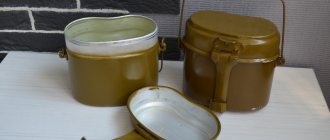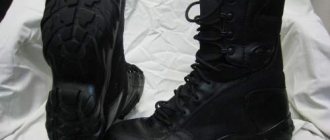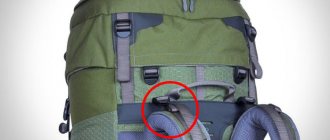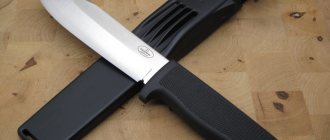No experienced tourist will go on a trip without a useful roll tied to his backpack. Which is not surprising, because when used correctly, a travel mat protects from cold and getting wet, levels the surface for comfortable sleeping, functions as a table, etc.
However, this does not mean that you can grab the first thing that comes to hand. If you want to fully enjoy your trip, choose and buy a rug “according to the weather and conditions.”
Why a travel mat?
A travel mat performs two main tasks: it prevents you from freezing and provides comfort. Moreover, the performance properties are determined by the type of model.
Function No. 1 – thermal insulation
Laying down directly on the floor of a tent or sleeping bag will leave you chilled to the bone, and in winter you will return from a hike with a cold. This is not surprising, because without an additional “insulating layer” the tent and sleeping bag do not protect against the cold coming from the ground.
Choosing a camping mat according to the weather is not difficult if you pay attention to its thermal insulation coefficient (R-Value). The higher the indicator, the more effective the protection against cold from below.
When choosing a rug for a winter hike or mountaineering trip that involves spending the night in snow-capped mountains, give preference to the product with the highest R-Value.
Function No. 2 – comfortable rest
To recuperate, tourists need good sleep. But the area chosen for a halt is not always smooth and soft. In most cases, the tent is set up on a rocky, hilly or frozen surface.
In the absence of a thick and soft rug, hard bulges dig into the back. It is unlikely that you will be able to fall asleep in such conditions.
What companies produce travel rugs?
Now almost every major brand has several carpet options. Most often these are self-inflators. Russian companies like RedFox or Tramp make several models, and if you can find interesting options from the former, Tramp and the bulk of cheap self-inflators on the market are made from the same patterns from the same materials and, I suspect, they are sewn in the same factories.
Much more interesting are top manufacturers such as Therm-a-Rest , Mammut (Ajungilak), Big Agnes , Sea to Summit and Exped . Their lines include all types of rugs, and they even make ordinary foams not quite ordinary. For example, Therm-a-Rest has an interesting mat, Therm-a-Rest Z lite (or Sol): it differs from foam in its structure, similar to an egg tray; with this shape, air pockets and, accordingly, the r-value increase, Plus, this mat easily and quickly folds into an accordion, slightly reducing the transport volume. You can also find rugs from Nemo on the Russian market, which are also very interesting and of high quality.
All rugs come in completely different shapes and sizes. To make the design easier, they often make an anatomical shape, and those who like ease of movement can purchase shortened versions. A short rug is placed only under the body, while under your feet you put all unused things: a backpack, running clothes, etc. In pursuit of grams, manufacturers offer completely futuristic options that look more like sculptures made of inflatable balloons, but it is claimed that they are very well thought out and support you only in those places where necessary. I haven’t had a chance to try the last option yet, but I hope someday I’ll get around to them and be able to write my impressions for you.
Interesting links
- Review of 20 rug manufacturers - www.risk.ru
- Review of the Therm-A-Rest NeoAir mat from traveler Timur Akhmetov - timurakhmetov.com
- Review of mats with descriptions of technologies and extensive discussion - risk.ru
- How to choose a backpack? —
- How to choose a sleeping bag? —
- How to choose a tent? —
Comments
What is not suitable for a tourist
Beginners often use an air mattress (at home) as a camp bed. However, the light, voluminous canvas has a significant drawback - it can only be inflated using a pump.
If you want difficulties, inflate a three-hundred-liter product with your lungs, and after returning from a hike, urgently go for a camping rug.
Bulky, heavy camping cots for car trips or stationary camps are not suitable for hiking. The only exception is the ultra-light model Term-a-Rest UltraLite Cot with a weight of 0.9 - 1.25 kg.
History of creation
About thirty years ago, a rug for tourists looked like an ordinary inflatable swimming mattress. It was made of thin rubber. Its only advantage was its small volume when deflated. This type of travel mat had a significant drawback: frequent and easy damage to the frame.
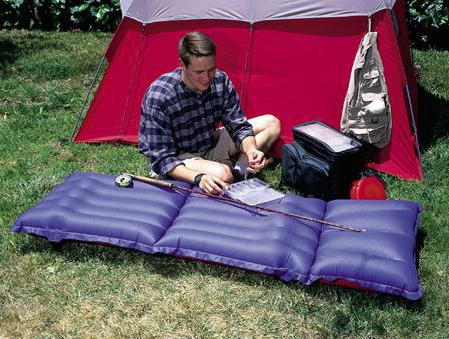
The 70s ushered in a new era for outdoor gear. New technologies began to be used in the production of foam materials, and air, as an excellent heat insulator, found its application in the manufacture of various models of rugs.
In 1985, an improved type of insulation, izolon, was invented based on foamed polymers.
What are travel rugs made of?
Travel mats are made from the following materials:
- Foil penofol (products with high insulating properties).
- Polyethylene foam (lightweight, resistant to mechanical damage, the mats are easily wrinkled and fit into a backpack).
- Polyester (inside polyurethane foam).
- Stitched isolon (wear-resistant products with a high thermal insulation coefficient - the best solution for a multi-day hike).
When looking for a camping rug for a hike, determine which material matches the operating conditions of the product. Then count the number of layers.
The simplest tourist mattress consists of two layers. Some manufacturers increase the insulating properties of the product by using foil.
On a note!
It is harder to sleep on a single-layer product, but it will last longer than a two-layer product.
Video material
Having considered all the types and options of what travel rugs are made from, it becomes obvious that they need to be used on hikes and even at home. Fans of active recreation and trips out of town for a picnic cannot do without them. Choose carefully so that it suits your needs and does not disappoint.
Choosing a suitable rug
Modern travel rugs (isomat) are divided into three classes:
- Self-inflating - filled with porous foam that expands when filled with air.
- Inflatable – the main volume of products is air. Some models are insulated with heat-reflecting materials or bulk insulation. Non-insulated mats are a lightweight and compact alternative to PVC mattresses.
- Karemats are made of layers of foam with closed cells.
Any of the listed rugs can be taken on a weekend hike or mountaineering. But it’s better to take into account the pros and cons and select an option suitable for a specific type of activity.
Mountaineering
At altitude, the wait for favorable weather conditions can last for several days. Oxygen starvation further undermines the climber’s strength and a warm, soft mat is necessary for proper rest.
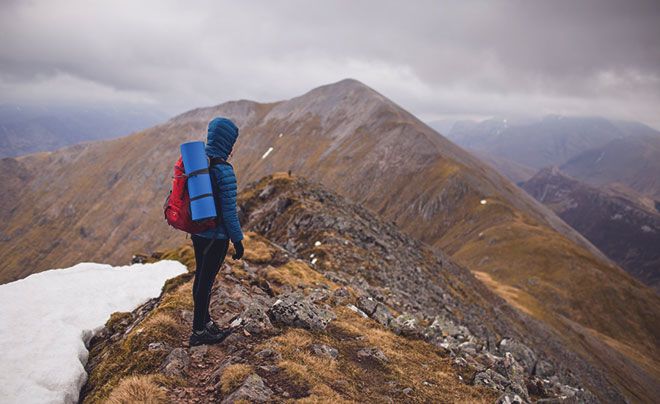
In base camp conditions, cover the single-layer sleeping mat with an inflatable mat. For difficult climbs, where you have to climb quickly and spend the night wherever you have to, an inflatable model is not the best solution.
The climber’s “spiky” equipment and sharp protrusions on the route will damage the mat, and this is a sure way to frostbite. Therefore, choose regular foam.
Hiking and mountain tourism
The best solution is a mat, especially an army one. Mountain hikes take place in extreme conditions, and you can only dream of relaxing in comfort.
Often you have to climb into a shelter in full gear, and this is dangerous for “inflatables”. While a foldable foam mat does not deteriorate even on broken glass or sharp stones.
Criterias of choice
The highest rating for your bed is how warm and comfortable it will be to sleep on. Select a suitable travel mat based on the following characteristics.
Comfort
Since winter hiking is entertainment for extreme sports enthusiasts (and there are not so many of them), the issue of comfort is more important than the degree of thermal insulation. Ideally, the rug is an elastic, soft and non-slip bed that can be easily folded and unfolded.
In terms of comfort, self-inflating mats, pleasant to the touch, lead the way. The smooth surfaces will not dig into your back, and thanks to the non-slip top coating, the sleeping bag or sheet will not “run away” during sleep.
A special air filling valve allows you to adjust the softness of the mat.
Wide and tall self-inflating camping mats will be useful not only in a stationary camp, but also at home (for example, if there are not enough beds to accommodate overnight guests).
It is difficult to choose a less comfortable camping rug than a sleeping mat. Thin, dense bedding material does not smooth out unevenness, so resting on a mattress is the lot of ascetics, minimalists, who are ready to give up comfort for the sake of the strength and light weight of the “foam”.
You can, of course, choose a comfortable and warm corrugated rug with a cellular structure (the thicker, the warmer). However, in this case you will have to put up with the greater weight and dimensions of the “foam”.
Note!
When choosing the type of rug, consider its suitability for your body type and hiking conditions.
Size and shape of the travel mat
The isomat folding mat is more convenient than the “Izhevsk foam” and takes up much less space in the backpack. The size and shape of the product determine its weight and how comfortable it will be to sleep on.
The size is indicated by the same letters as the clothing size chart: S (small), M (medium), L (large). Each designation corresponds to a specific length and width of the product. Moreover, each manufacturer has its own parameters.
The length of the rug can vary between 90 and 197 cm. “Shorty” ones were invented for those who are used to being limited to the minimum.

Products with a length of 120–130 cm are placed under the pelvis and torso of the tourist. In order not to freeze and sleep at least in relative comfort, a gutted backpack is placed under the feet, and a supply of clothes rolled up under the head.
The most popular rugs with a length of 183 cm (corresponding to size “M”). In combination with the width of 53 cm, the product is ideal for a tourist of average build.
The longest rugs are designed for tall people or for camping.
On a note!
Women's models are shorter than the unisex version, but they are much warmer (suitable not only for girls, but also for short, cold male tourists).
When planning to use a rug for a tent and buying several products at once, keep in mind that their width when unfolded should not exceed the width of the bottom of the tent (if they overlap, they are unlikely to provide a comfortable sleep).
For traveling together, a double ultralight inflatable mat or camping mattress is suitable.
The travel mat has a rectangular or cocoon-shaped shape. The second option weighs less and fits perfectly into a tent with a trapezoidal bottom.
A short inflatable mat that tapers downward is not the best option for a man with a strong physique. And the wide rectangular isomat is not suitable for a fragile girl (yes, you can sleep like a king on it, but you need to carry it in your backpack, and it weighs a lot).
Wrong size or shape and... goodbye to the pleasure of hiking. Therefore, “try on” the rug in the store.
Thermal insulation of tourist carpets
Even the warmest sleeping bag, compressed by the body of the sleeper, is not able to retain heat or protect a person from the cold coming from below. Therefore, without an insulating layer, you can freeze, catch a cold, rheumatism and many other “surprises”.
Types of rugs
Closed cell foam mats or "foam" mats
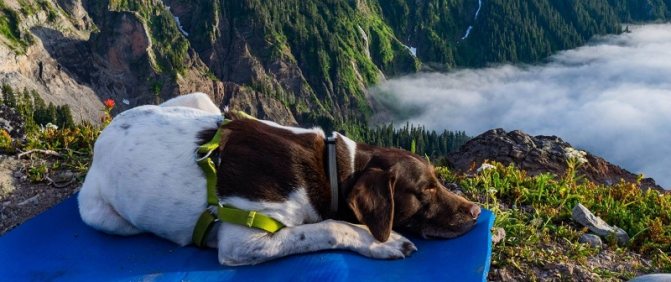
These are the simplest, most economical, easy to use and care for rugs. Perfect for beginner hikers and campers.
Such rugs have been produced since the mid-60s of the 20th century. The material used to make them is polyethylene or ethylene vinyl acetate. Both have a closed-cell structure. This means that the material is sealed and protected from moisture getting inside, unlike the open-cell structure of the well-known material, foam rubber. “Foams” are not afraid of punctures, unlike “inflators” and “self-inflators”. The downside to such rugs is their rather large volume. A roll of “foam” takes up a relatively large amount of space; attached to the outside of the backpack, it clings to bushes and tree branches, causing it to get scratched and deteriorate. In addition, sleeping on such a rather hard rug can be uncomfortable for a modern city dweller.
All the “foam” in “Kant”
Excellent foam mats made from upgraded polyethylene foam (XLPE) are made under the Therm-a-Rest® brand by the American company Cascade Designs. The brand was founded by two former aviation engineers and part-time avid tourists, John Burroughs and Jim Lea, in the seventies of the last century.
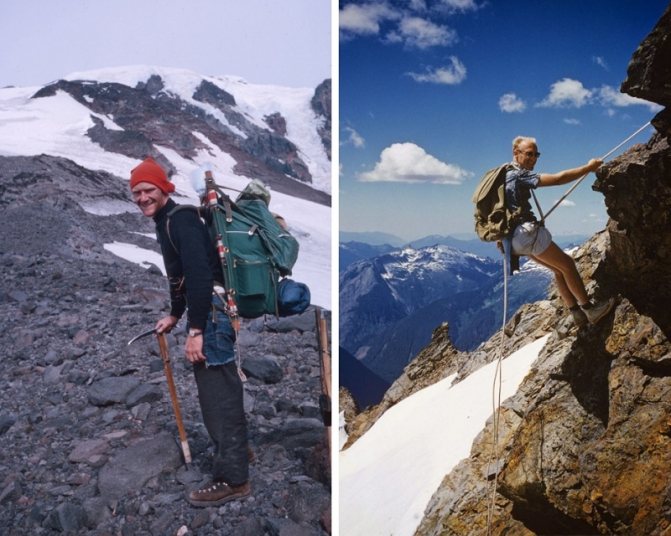
Production is located in the USA and Ireland, which allows for the highest quality control of products. In addition to all standard testing procedures, before being sent to the consumer, absolutely all rugs of this brand are inflated and remain in this form for 24 hours so that defects can be tracked.
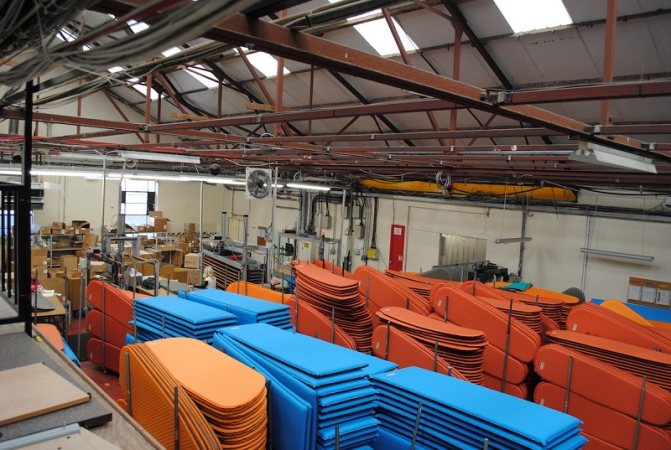
The Therm-a-Rest® RidgeRest and Therm-a-Rest® Z Lite models have been in continuous production since 1986 and 1989, respectively.
The Therm-a-Rest® RidgeRest model has longitudinal-transverse corrugation. When you lie down on it, air is retained in these recesses on the surface of the mat, which provides additional thermal insulation. Corrugation also helps to slightly reduce the overall weight of the product without losing its thermal insulating properties. In addition, tent condensation easily collects in the recesses and almost does not wet the sleeping bag.
The mats are available in a regular version and with an aluminized coating, which reflects heat coming from the body. The R-value of the standard Therm-a-Rest® RidgeRest is 2.0, and with a heat-reflecting layer - 2.1, which is quite enough for use in both summer and non-cold off-season.
The Therm-a-Rest® Z Lite model from the same company has a compact accordion folding system. When folded, such a rug takes up significantly less space than regular rolls.

The joints of the accordion segments are additionally reinforced, do not allow heat loss and have the same thermal insulation as the entire rug. Cellular corrugation increases the “warmth” of the mat through the use of air chambers, and when folded, the cells fit into each other and reduce the packaging volume. It is convenient to use such “foams” as seats, laying out the required number of sections. Just like the RidgeRest model, there is an option with an aluminized heat-reflecting coating. The standard Therm-a-Rest® Z Lite has an R-value of 1.7, while the aluminized version has an R-value of 2.0. Both rugs have proven themselves excellent both as independent “foam” for summer hikes, and as the first layer on which an inflatable or self-inflating rug is laid during frosty overnight stays.
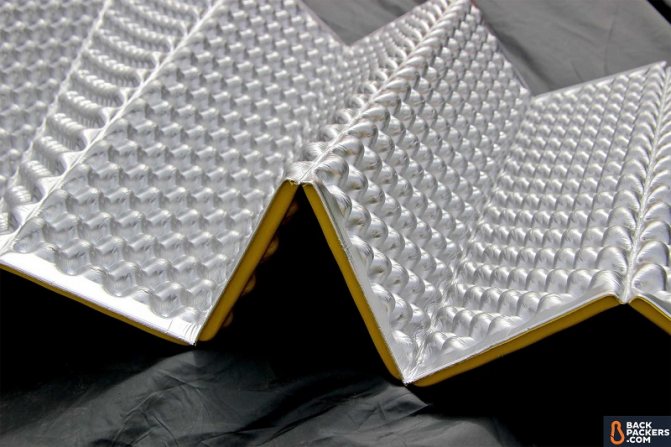
Travel mat THERM-A-REST ridgerest solite regular silver/sage
3 300
Travel mat THERM-A-REST ridgerest classic regular charcoal
2 350
Travel mat THERM-A-REST z lite regular coyote/gray
4 250
Travel mat THERM-A-REST z lite sol regular silver/limon
4 700
Buy
All folding rugs at Kant
Inexpensive, simple “foams” for the summer are produced by Tramp, Nova Tour and Imbema.
Travel mat Tramp 2020 optima light s12
680
Buy
Travel mat Nova Tour tourist 8mm (two-layer PPE)
630
Buy
-30%
Travel mat Imbema himalaya nato green
693 990
-50%
Tourist mat Imbema souplesse 10-m 180×60cm red
1 005 2 010
Self-inflating mats
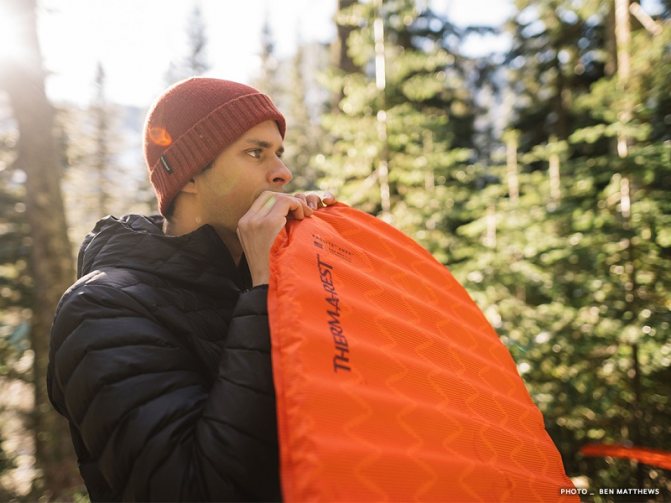
These mats are a sheet of open-cell foam material, most often high-quality, modern foam rubber. Such a sheet is packaged in a thin water- and air-tight shell, to which a valve is attached to allow air access. The mat has a spongy structure, is easily compressed and also easily restores its shape. Since the foam material allows air inside, and the shell prevents it from escaping, self-inflating mats retain heat well with a relatively low weight and packaging size. You just need to open the valve, straighten the mat and the foam inside will absorb air on its own. After this, you need to blow a little inside to give the necessary rigidity and close the valve. The mat is now ready to use! “Self-inflators” are much more compact when folded than “foam” ones and are superior to them in comfort. Thanks to their thickness and soft structure, they effectively smooth out all uneven terrain: protruding stones, roots, cones and twigs. Sleeping on such a rug is many times more pleasant than sleeping on a regular foam mat.
They have, perhaps, only one drawback - vulnerability to punctures. You can no longer sit on such a rug in the evening by the fire, or sunbathe while on vacation during the day. “Self-inflating bags” without the use of additional bedding are recommended to be used only in a tent. For obvious reasons, they are afraid of sparks, sharp stones, dry hard grass and sharp objects: climbing crampons, equipment parts, saws, knives and other things. You should not leave the rug in the bright sun for a long time: the air inside expands when heated and can damage the product.
All self-inflating mats at Kant
For the first time, self-inflating mats were produced by the American company Cascade Designs. From 1972 to the present day, their Therm-a-Rest® brand remains one of the best in the world.
Therm-a-Rest® currently produces 3 lines of its rugs: “Fast & Light”, “Trek & Travel” and “Camp & Comfort”. The first two are perfect for tourism and mountaineering, and the last one is for those who like to travel with increased comfort, family campers and residents of large base camps.
The rugs are available in several sizes. This allows you to individually select a mat for users of different heights and builds. There are special models for women. They are smaller than standard ones, and their R-value is higher.
Therm-a-Rest® Fast & Light series: minimal weight and packaging volume, relatively thin shell.
Mat Self-inflating THERM-A-REST prolite plus regular poppy
10 850
Mat Self-inflating THERM-A-REST prolite large poppy
12 700
Buy
Mat Self-inflating THERM-A-REST prolite plus regular mountain print
10 820
Mat Self-inflating THERM-A-REST 2020 prolite apex heat wave r
14 500
Buy
Therm-a-Rest® Trek & Travel series: the golden mean of comfort, strength and lightness.
Self-inflating mat THERM-A-REST 2020 trail lite trooper r
8 490
new
Self-inflating mat THERM-A-REST 2020 trail pro pine r
Self-inflating mat THERM-A-REST 2020 trail lite trooper wr
8 490
Mat Self-inflating THERM-A-REST women's trail lite regular grasshopper
7 550
Therm-a-Rest® Camp & Comfort Series: maximum warmth and softness, significant weight and packaging volume.
Self-inflating mat THERM-A-REST 2020 basecamp l poseidon blue
11 500
new
Mat Self-inflating THERM-A-REST 2020 mondoking 3d l blue
new
Self-inflating mat THERM-A-REST 2020 mondoking 3d xxl blue
Self-inflating mat THERM-A-REST 2020 basecamp xl poseidon blue
13 500
In the new season, the company has updated the design of its rugs. All Therm-a-Rest® camping mats now feature a WINGLOCK™ valve, and large, thick camping mats now feature two TWINLOCK™ system valves for added convenience.
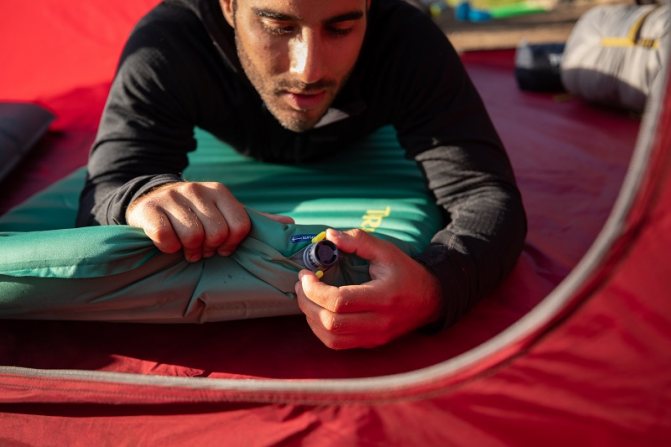
By the way, the classic Therm-a-Rest® valves have remained virtually unchanged since 1972. The only change over the years was that they were made from plastic instead of brass.
WingLock™ and TwinLock™ valves are a completely new product. After hundreds of prototypes and over 500 nights of field testing, the developers have created convenient, state-of-the-art valves that allow you to easily inflate/deflate your mat, while being very durable, easy to handle, resistant to mechanical stress, heat and cold, dirt and dust, and They are well repairable in case particularly talented tourists manage to break them.
Therm-a-Rest Valves: WingLock™ and TwinLock™ Valve Overview
Therm-a-Rest: How to use the WingLock™ Valve
The WingLock™ valve works on the principle of a nipple: it allows air to flow only in one direction when inflating. You no longer have to hastily close the valve to prevent air from escaping - the automation works reliably.
To instantly deflate the mat, just turn the “wings” of the valve and twist the lid to the left. Due to the rather large diameter of the hole, the air escapes quickly. A slight turn of the “wings” before partially twisting the valve cover will allow a small portion of air to escape. This is true if you just want to deflate the rug a little, for example, so that it better hides uneven terrain, stones, branches or cones underneath you.
In the TwinLock™ system, in order to further improve ease of use, in addition to the main one, there is also a second valve that works for deflation. This has significantly improved the comfort and speed of packing.
All operations with the new valves are simple and intuitive, even for those who have never used self-inflating mats in their lives before.
Another company that successfully produces rugs is Sea to Summit.
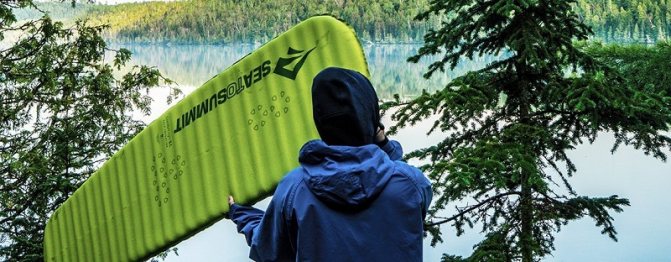
This is a young brand founded in 1990 in Australia. Its assortment includes largely unique and, undoubtedly, useful equipment for outdoor and travel in the broadest sense: waterproof covers, microfiber towels, folding silicone dishes, other tourist items, backpacks, sleeping bags and much more. Maximum functionality with minimal weight is the main feature of this company’s products.
Special, large article review of necessary Sea to Summit accessories
This fully applies to rugs.
Australians have many of their own developments. This is also a special reversible nipple valve, similar in principle to Therm-a-Rest® systems. And Delta Core™ technology, which is a system of chambers of different volumes inside the mat. In areas of maximum contact with the body (shoulders, hips, feet) the chambers are small for greater rigidity, and in other areas where the pressure is not so strong, on the contrary, the chambers are larger, due to which it was possible to reduce the weight of the mat by 20 percent without reducing its thermal insulation properties. The Pillow Lock™ pillow fixation system is also interesting, when you can use Velcro to secure the Sea To Summit Eros inflatable pillow to the mat. It’s convenient when the pillow doesn’t “move” anywhere from under you while you sleep, isn’t it?
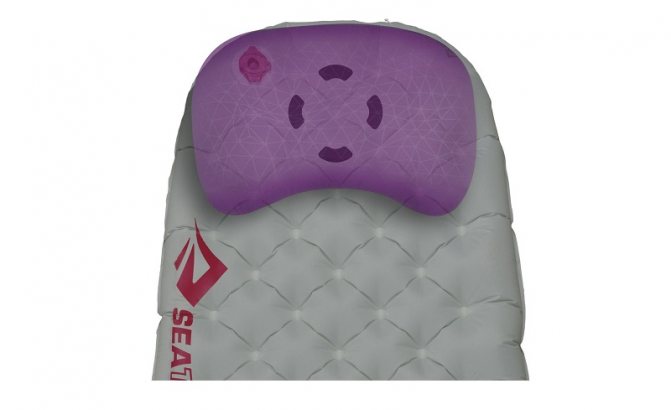
The Australian company makes rugs for a variety of conditions. They have ultra-light, medium universal, and thick comfortable models.
Self-inflating mat Sea To Summit 2020 comfort light self inflating regular green
12 300
Buy
new
Self-inflating mat Sea To Summit ultralight self inflating mat regular orange
9 600
Buy
Self-inflating mat Sea To Summit comfort plus self inflating regular red
13 000
Buy
new
Self-inflating mat Sea To Summit 2020 ultralight self inflating women's regular paprika
Budget self-inflating mats for summer are made by Russian brands Red Fox and Tramp, as well as the Italian company Salewa.
They are suitable for camping, light hiking and outdoor recreation. Such mats are an excellent option for those who want to try what a self-inflating mat is for the first time, but are not yet ready to part with a significant amount of money to purchase it.
athlete price
Travel mat Salewa mat comfort applegreen/grey
7 490
Buy
new
Mat Self-inflating Red Fox 2020 pro mat light amber
Mat Self-inflating Tramp 2020 tri-004 fastened
2 600
Mat Self-inflating Tramp 2020 ultralight tpu 2.5 cm tri-022
2 800
Inflatable mats

These are champions in lightness and size when folded. Almost all rolled up “puffers” will take up no more space in your backpack than a liter flask. With minimal weight they have a very high level of thermal insulation. For example, the Therm-a-Rest NeoAir® XLite mat weighs 340 grams and has an R-value of 4.2, meaning you can sleep on it at surface temperatures down to -12°C.
Their main drawback is their vulnerability to punctures. Without retaining air inside, such rugs lose all their heat-saving functions. Therefore, they require especially careful handling. You should not use the mat outside the tent without additional lining, for example, from ordinary “foam”.
It is also necessary to protect it from direct sunlight. And when inflating (especially with a pump), you don’t need to try to force too much air inside: this certainly won’t make the rug warmer, but damaging its internal structure and getting a so-called “hernia” - swelling is quite possible.
One of the leading leaders in this equipment segment is the same company Cascade Designs, which makes rugs under the Therm-a-Rest® brand. Their NeoAir “inflatables” were born in 2009. Since then, the quality of production and the company’s own technologies have made this series very popular among tourists, climbers and outdoor enthusiasts all over the world. Among the interesting engineering solutions, it is worth noting THERMACAPTURE™ - a system of layers of foil material inside the mat, which reflects back the heat coming from you, significantly reducing its loss. And TRIANGULAR CORE MATRIX™ and WAVE CORE™ technologies - thoughtful chains of partitions inside - prevent air migration, and therefore heat loss, and make the mat more stable and comfortable.
Due to the foil insulating layers inside, Therm-a-Rest® inflatable mats rustle a little when you toss and turn on them, but that's a small price to pay for a warm, comfortable overnight stay, isn't it?
All modern “inflators” from this company include a special hermetic bag-pump for inflation.
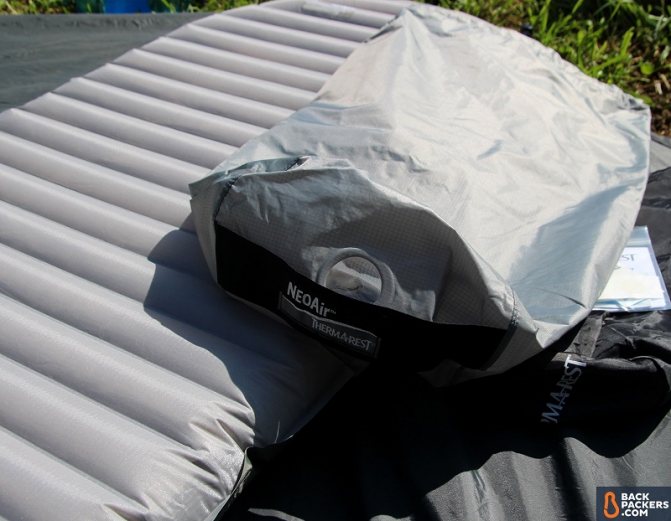
The Therm-a-Rest NeoAir® UberLite™ mat deserves a special mention. This is a real dream for light walkers, and when used with a “foam” bedding, it can be successfully used by climbers during ascents above the snow zone and by winter tourists.
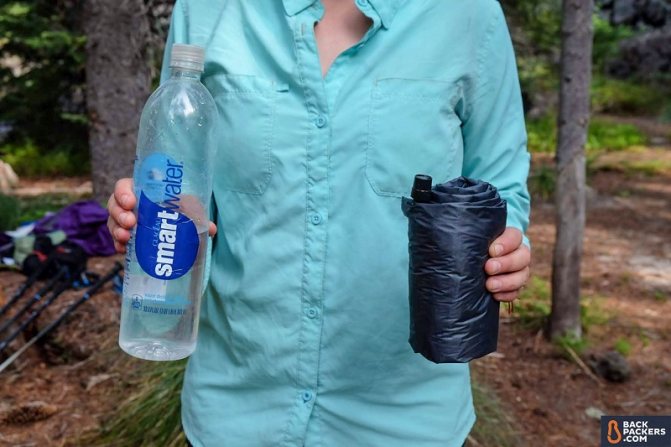
Source: backpackers.com
Weighing 250 (!) grams in a standard size of 183 by 51 cm and a luxurious thickness of 6.4 cm, which allows you to hide bumps, stones, cones and other irregularities under the sleeper, it is packed to a cylinder with dimensions of 15 by 9 cm, which is approximately equal to a can of beer (non-alcoholic, of course). And all this with an R-value of 2.3, which is quite enough for any summer hike up to the middle mountains. The thin shell, according to the developers, is ready to withstand the most severe loads. In the official Therm-a-Rest® video, a car is dashingly rolled over this mat without any harm to the product. For those still in doubt, the kit includes a repair kit.
Therm-a-Rest NeoAir® UberLite™ Ultralight Sleeping Pad
Inflatable mat THERM-A-REST 2020 neoair topo print r
12 950
Buy
new
Inflatable mat THERM-A-REST 2020 neoair topo luxe balsam r
Inflatable mat THERM-A-REST 2020 neoair uberlight orion r
20 200
Mat Self-inflating THERM-A-REST basecamp large posidon blue
10 400
Inflatable mats from the Australian company Sea To Summit have also proven themselves well: Ultra light Insulated and Comfort light Insulated. A distinctive feature of this company’s products is an additional insulating layer made of Thermolite synthetic material. These are hollow fibers inside, which are laid in the air chambers of the mat, like in a down jacket, which provides excellent heat conservation with minimal weight and volume.

In addition, their products use Exkin Platinum technology - this is a lightweight, non-rusting, non-woven material with a thin metallized layer that reflects heat. Both of these materials, together with air, form an effective barrier to prevent heat from escaping into the cold ground.
To increase durability, Sea To Summit inflatable mats are lined with thermoplastic polyurethane (TPU) on the inside. This material is a thin but durable film, which during production is soldered to the shell into a single dense layer and does not delaminate over time. Such a mat is much more resistant to tearing and tearing loads, ultraviolet radiation, contamination with sebum, oils contained in sunscreens and other unfavorable factors. In addition, when you inflate the mat with your mouth, moisture can get inside along with the exhaled air and fungus can form. TPU coating prevents possible fungal development.
To protect users as much as possible from problems with inflation, all similar Sea To Summit mats include a special Airstream pump bag for quickly inflating them with air.
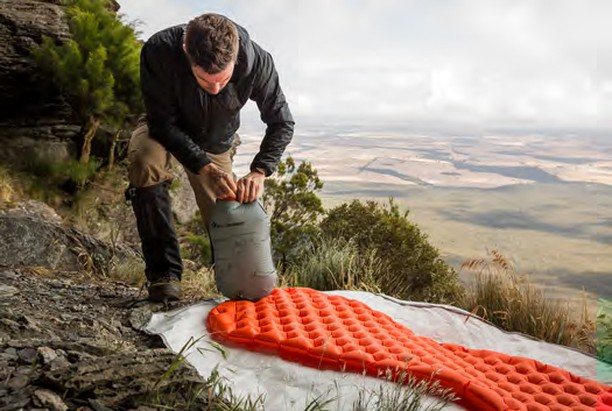
Weighing from 37 to 60 grams (depending on the mat model), it allows you to quickly and safely bring the mat into “combat” condition. In addition to all the other advantages (fast inflation, protection from fungus), when inflating the mat with a pump, air approximately equal to the ambient temperature enters inside, in contrast to inflating with your mouth, when you fill it with warm air. As the temperature drops at night, the warm air inside the mat cools and decreases slightly in volume. The rug loses its elasticity. Sometimes this may even require additional pumping, which, you see, is not very convenient to do on a dark, cold night. When inflated using a bag pump, the temperatures of the ambient air and the air entering the mat are equal, which means this problem is solved.
In addition to its main purpose, the pump can be used as a regular hermetic bag for a sleeping bag or clothing.
Inflatable mat Sea To Summit ultralight insulated mat regular orange
12 400
Buy
Inflatable mat Sea To Summit comfort light insulated mat regular green
16 800
Buy
Inflatable mat Sea To Summit comfort light insulated mat large green
14 400
Inflatable mat Sea To Summit comfort light insulated mat large green
18 700
Buy
How to buy a travel mat correctly?
Each travel mat model has its pros and cons. And the choice is so great that a novice tourist gets lost and buys the obvious “wrong” thing.
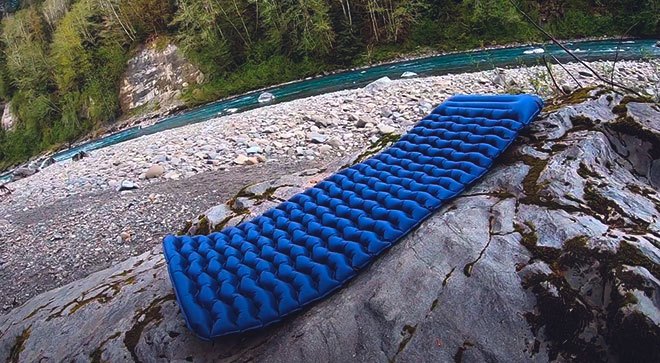
The following cheat sheet will help you balance the combination of what you like and what suits you, and not throw money away.
When should you buy a mattress?
- There is not enough money for a more expensive model. Affordable foam is affordable for any tourist, and it can be changed at least every three months.
- For covering long, easy routes with a small backpack in the warm season. Reliable, multifunctional and lightweight travel foam meets all requirements for ease of movement.
- As a bottom layer for a “puff up”. The mat will protect the isomat from punctures and increase the overall thermal insulation of the camp bed.
When is the best time to buy a self-inflating mat?
- A reasonable compromise is needed: price, weight, comfort, durability. Touring models are suitable for almost all types of outdoor activities.
- As a light, compact and warm alternative to a PVC home mattress. The camping model is suitable for a summer house, home or overnight camping.
When do we buy an inflatable insulated mat?
When the most effective ratio is required: comfortable sleep, weight, warmth. The advantage is indispensable in the mountains or on long winter expeditions.
But even a backpacker who is far from extreme sports is unlikely to refuse the tempting combination of convenience and comfort.
When do we buy an inflatable non-insulated mat?
- A lighter and softer alternative to the usual tourist foam. The thermal insulation of the product is sufficient for the warm season, and its durability is sufficient for use outside a tent.
- As a lightweight and compact alternative to a PVC air mattress (country picnic, nowhere to accommodate guests for the night, camping, etc.).
A tourist rug or “foam” is one of the most popular attributes of a country holiday and beyond. It finds worthy use in almost any situation, be it exercises in the gym, a picnic, fishing, relaxing at a summer cottage or a high-grade hike. There are a lot of names for such a rug - foam , foam rug , tourist rug, karemat , etc. The most widely known are rugs made from Izolon (one of the names for polyethylene foam), produced at the Izhevsk Plastics Plant. But few people know that Izolon can differ in its properties, which, of course, entails differences in the properties of travel rugs.
Most materials such as Izolon, or rather polyethylene foam, produced at the Izhevsk Plastic Plant are widely used as a sealant, shock absorber, as well as for steam, sound and thermal insulation in more than a dozen areas: construction, mechanical engineering, automotive or food industries, medicine etc. These materials have different densities and most of them are completely unsuitable for making travel rugs. Isolon, used in sports goods, is only a small part of the total variety of IZP materials produced. Let’s try to figure out which grades of Izolon material can and should be used to make a travel mat.
Izolon brand PPE NH is a chemically cross-linked polyethylene foam with a density of 20 kg/m3. Rugs with large mesh, rough and scratch-resistant surface. Minus - they absorb water a little, plus - the most budget option. Existing analogues from other manufacturers - Poliform, Yurim, Penolon
Izolon brand PPE is physically cross-linked polyethylene foam with a density of 25 kg/m3. Compared to the previous one, it has greater durability and resistance to influence, both physical and temperature. Rugs with a small cell, very springy, do not absorb water.
Izolon brand PSEV is a physically cross-linked penosevilene with a density of 33 kg/m3. In comparison with Izolon PPE penosevilene has improved physical and mechanical properties, in particular low residual deformation, incl. and during cyclic compression. Density range - 33...200 kg/m3. These small cell mats are the best that can be offered - they are very springy, almost completely restore their volume after being crushed, do not absorb water, and do not slip.
However, to choose a travel mat wisely, you must also take into account the fact that Izolon of the same brand can have different densities and thicknesses. You can determine them by looking at the marking - four numbers (3005, 2008 1510), of which the last two (05, 08, 10, 12 and 16) are the thickness, the first ones are the density, or rather the foaming ratio. According to the plant’s specifications, a foaming ratio of 15 corresponds to a density of 66 kg/m3. The foaming ratio is 20 and 30, respectively, meaning a density of 50 kg/m3 and 33 kg/m3. Thus, a rug with the first two numbers 15 is denser than a rug with numbers 20 or 30.
- From this we conclude that:
- For training in the gym, a PPE and PSEV 3005, 2005 or 1505 mat is quite suitable, but a more elastic PSEV is better. A thickness of 5 mm is sufficient for indoor use, but the rug can be folded compactly.
- for summer overnight stays in a tent, outdoor recreation or picnic, it is preferable to choose a PPE and PSEV mat 3008 and 3010, 2008 and 2010, 1508 and 1510. These 8 and 10 mm thick carpets will protect you from the cool and provide comfort.
- Well, in order to be sure of safety when spending the night in cold weather, you cannot do without a dense and thick rug PPE and PSEV 3012, 2012 and 3016, their thickness of 12 and 16 mm will serve as a reliable thermal insulator. For additional thermal insulation, many experienced tourists recommend laying a soft 5 or 8 mm mat between such a rug and a sleeping bag, for example PPE NX or PPE 3005 or 2008. It is easily packed and takes up minimal space, and the effect will be significant.
Various modifications of the described materials are also produced for tourism and recreation. Like, for example, a rug, one of the sides of which is covered with fabric. They are produced by the same Isolon PPE and PSEV with a thickness of 8 or 10 mm. This can be a good option for a summer holiday - the fabric side of the rug is more pleasant to the touch. But when it gets wet, such a rug will be “out of action” for a long time; it’s unpleasant for anyone to sit, much less lie on a wet cloth.
Some people prefer rugs covered with a durable metallized film, which gives greater strength than simple rugs and creates an additional heat reflection effect. By the way, such a rug can also be used as an additional layer for cold nights.
For children and aesthetes, we can recommend rugs with a pattern. It is only necessary to take into account that when choosing a rug for a child, you should refuse Izolon brand PPE NX, Penolon or Poliform, since the coating of chemically cross-linked polyethylene foam should not come into contact with the child’s skin. An exception may be rugs with fabric or film covering.
Do-it-yourself karemat
The first sleeping mats in the form of rubber air mattresses appeared in 1824. They were improved, but still remained too heavy and sensitive to mechanical damage.
In the second half of the twentieth century, the British company released a polyurethane foam mat, which defeated its inflatable predecessor. This is where the name came from - karemat.
To this day, the popularity of this practical product has not subsided. Moreover, some people arm themselves with construction foam (isolon) and make a rug with their own hands.
Here's how it happens:
- Thick isolon is selected according to the expected weather during the hike.
- The height, width of the shoulders, waist and hips of a person are measured.
- According to the most convex indicators, a rectangular rug is cut out (if necessary, wider than a store-bought one).
- Cuttings glued together make excellent seat mats for long periods of sitting on cold ground or rocks.
Advice!
Wash the polyethylene foam mat with warm soapy water, without chemicals. To prevent the product from becoming deformed, protect it from contact with boiling water and exposure to high temperatures.
